Pansies, those charming little flowers, are a vibrant canvas of nature’s colors. From the richest purples to the softest yellows, pansies showcase a kaleidoscope of hues that can brighten up any garden or window box.
These dainty blooms come in a wide array of colors, making them a favorite among garden enthusiasts and flower lovers alike. Whether you prefer the cheerful face of a sunny yellow pansy or the royal elegance of a deep violet one, pansies offer a palette of options to suit every taste.
What Are Pansies?
Pansies, scientifically known as Viola tricolor, are a captivating and vibrant group of flowering plants that have long captured the hearts of gardeners and nature enthusiasts around the world.
Classification and Botanical Profile
Pansies belong to the Violaceae family, which encompasses a wide array of flowering plants. Within this family, they are part of the Viola genus, a group that includes other well-known species like violets. The scientific name, Viola tricolor, hints at the pansy’s intricate petals, which often display a striking combination of three different colors.
The most notable characteristic of pansies is their distinctive five-petaled flowers. These petals are symmetrical, forming a charming “face” that gives pansies their endearing quality. The flowers come in various shades, from rich purples and blues to vibrant yellows, oranges, and whites, creating a kaleidoscope of colors in gardens and landscapes.
Origin and Historical Significance
Pansies have a rich history dating back to ancient times. Their name, “pansy,” is derived from the French word “pensée,” which means “thought.” This name alludes to the flower’s resemblance to a pensive face, with two upper petals forming a pair of eyes, and a lower petal often resembling a nose or mouth.
Pansies are native to Europe and Western Asia, where they have been cultivated and admired for centuries. In the 19th century, their popularity surged in England, and they became a symbol of remembrance and love. People exchanged pansies as tokens of affection, and their delicate beauty graced many Victorian gardens.
Unique Characteristics of Pansies
Pansies are versatile plants that can thrive in various conditions. They are often grown as annuals, biennials, or short-lived perennials, depending on the climate and local growing practices. This adaptability makes them a favorite choice for gardeners in different regions.
Pansies are also known for their ability to thrive in cooler temperatures, making them a staple in early spring and fall gardens. They can withstand light frost and continue to bloom when many other flowers have faded.
Pansies can also offer an astonishing array of colors and patterns, making them a canvas for creative garden designs. From solid, bold hues to delicate, multi-colored blends, these flowers provide endless possibilities for adding visual interest to landscapes.
Beyond their ornamental value, pansies have been used in traditional herbal medicine and culinary endeavors. Their petals are edible and can be added to salads, desserts, and beverages for a touch of color and a mild, slightly sweet flavor.
Pansies can also be excellent pollinator magnets, attracting bees and butterflies to your garden. Their nectar-rich blooms provide sustenance for these vital insects, contributing to overall garden health.
Lastly, pansies are relatively easy to care for. They require well-drained soil, regular watering, and a good dose of sunlight, but they are not overly demanding. Deadheading spent blooms can encourage continuous flowering.
Caring for Pansies
Caring for pansies, while not overly demanding, does present its challenges. These charming flowers thrive in cool weather but can struggle in extreme heat. Maintaining the right balance of moisture in the soil can be tricky; it’s crucial to keep it consistently moist without overwatering, as they are susceptible to root rot. Neglecting to deadhead spent blooms can also hinder their continuous flowering.
Pests like aphids and slugs may target pansies, requiring vigilance and occasional pest control measures. Fertilizing, while necessary, must be done in moderation to avoid excessive growth or legginess. Additionally, soil quality plays a crucial role, necessitating well-drained soil and occasional soil testing to ensure proper pH levels.
Despite these challenges, with attentive care, pansies can reward gardeners with their vibrant and captivating blossoms. Their resilience in the face of adversity often makes them a worthwhile addition to gardens, offering a touch of color and charm even in less-than-ideal conditions.
With all of this in mind, let’s look at all of the colors of pansies!
1. Purple
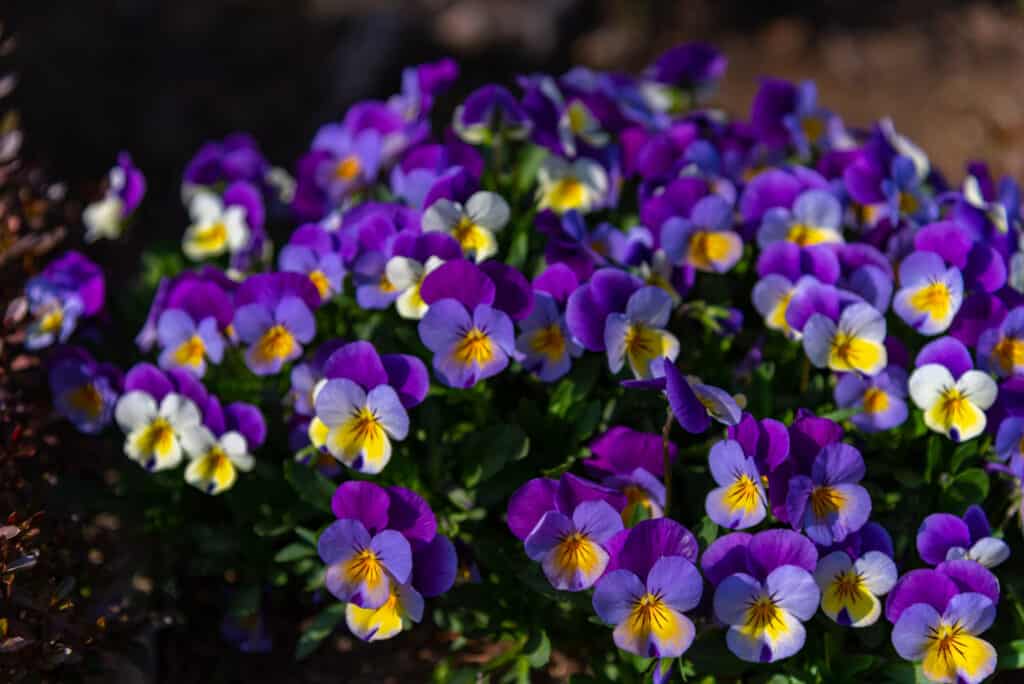
This type of pansy symbolizes admiration and love.
©Shawn.ccf/Shutterstock.com
Purple pansies, those exquisite gems of the garden, derive their striking purple hues from a class of natural pigments called anthocyanins. These pigments, present in pansy petals, manifest in a breathtaking spectrum of purples, ranging from deep and velvety to soft and lilac. The result is a captivating bloom that has enamored gardeners for generations.
One of the most recognized purple pansy varieties is the ‘Purple Rain.’ Its petals exude a rich, royal violet shade that commands attention. Then there’s the ‘Majestic Giant II,’ known for its large, lush blooms that boast a regal purple hue. For those with a penchant for subtlety, ‘Delta Lavender Shades’ pansies offer a more delicate, pastel take on purple, casting a gentle, soothing aura.
Symbolically, purple pansies carry significant meaning. Traditionally, these flowers symbolize admiration, making them an ideal gift to convey heartfelt appreciation. They’re also a symbol of thoughtfulness, serving as a token of remembrance and care. In the language of flowers, pansies carry the message of loving memories and sentiments of affection. Furthermore, the color purple has long been associated with notions of royalty, creativity, and dignity. As such, purple pansies represent elegance and sophistication, making them a graceful addition to any garden or floral arrangement.
2. Yellow
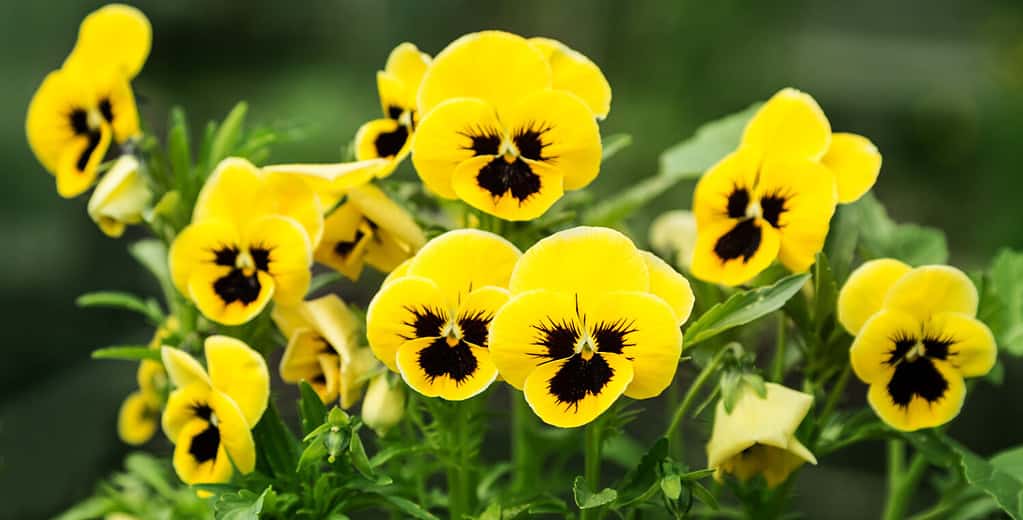
This type of pansy symbolizes joy and platonic friendship.
©Mariia Khamidulina/Shutterstock.com
Yellow pansies, with their sunny disposition and vibrant petals, are a cherished presence in gardens worldwide. These cheerful flowers derive their distinctive yellow color from natural pigments known as carotenoids, which are responsible for the bright and sunny hues that grace their delicate blooms.
Among the array of yellow pansy varieties, the ‘Canary’ pansy stands out with its intense, pure yellow petals that evoke the brilliance of a canary’s plumage. ‘Gold Rush’ pansies offer a softer, golden-yellow shade, reminiscent of a warm summer’s day. ‘Sunbeam’ pansies, on the other hand, bring a touch of sun-kissed radiance with their pale yellow petals that seem to capture the gentle morning light. These diverse options allow gardeners to infuse their landscapes with varying shades of yellow, each conveying a unique charm.
Symbolically, yellow pansies represent joy, happiness, and friendship. Their vibrant color radiates positivity, making them a wonderful gift to bring cheer to a loved one’s day. Yellow pansies can also symbolize new beginnings and renewal, making them a thoughtful choice for occasions such as weddings and graduations. The color yellow itself is often associated with optimism, energy, and enlightenment, further enhancing the symbolism of these sunny blooms.
3. Black
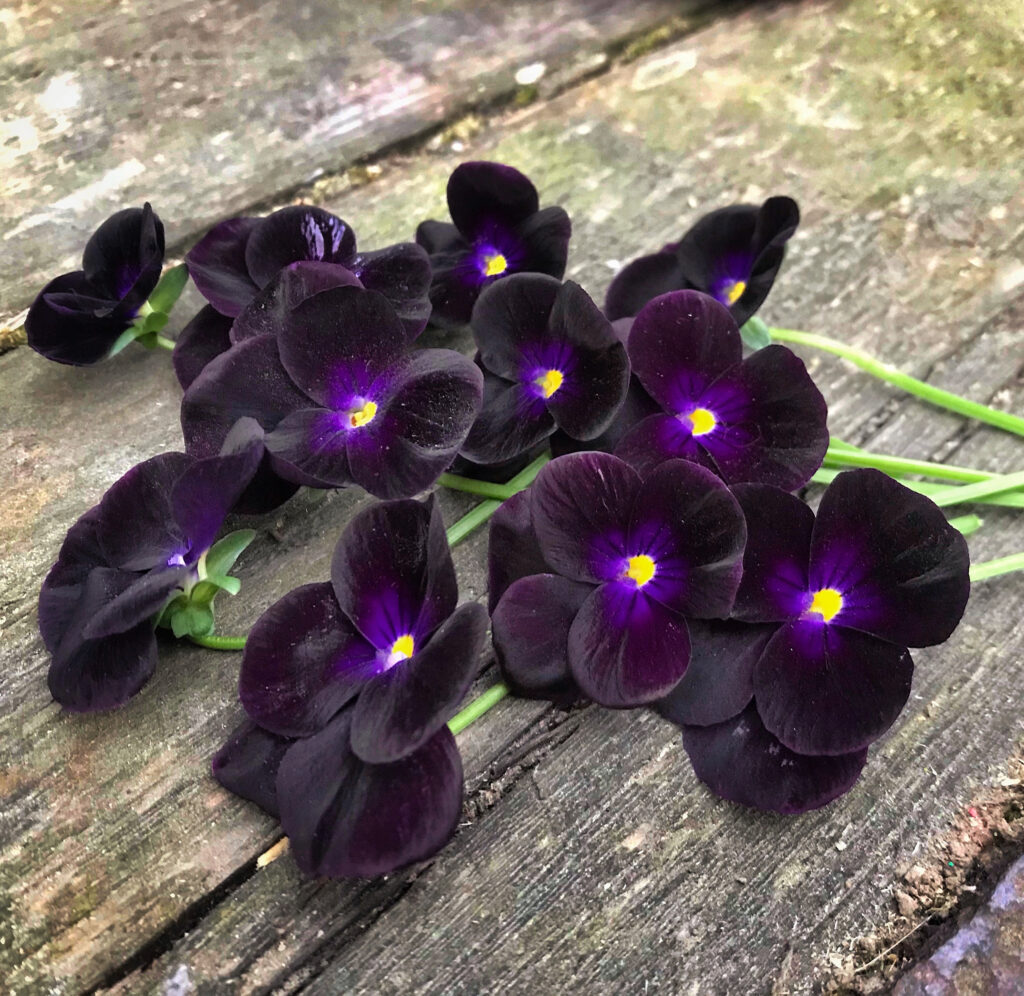
This type of pansy symbolizes mystery and secrets.
©OlgaKuznetsova7/Shutterstock.com
Black pansies, with their enigmatic and dark allure, are a captivating presence in the world of flowers. Contrary to their name, they are not truly black but rather exhibit deep, velvety shades of dark purple or maroon. This captivating hue, often mistaken for true black, adds a touch of mystery and elegance to gardens and floral arrangements.
One of the most notable black pansy varieties is the ‘Black King.’ Its petals are a rich, velvety purple with dark undertones that evoke the essence of regal sophistication. Another exquisite option is the ‘Black Beauty’ pansy, which boasts deep maroon petals with an almost black center. These varieties showcase the enchanting spectrum of colors that black pansies offer, ranging from deep purple to near-black shades.
When it comes to what they symbolize or mean, black pansies hold a unique significance. They are often associated with mystery, depth, and the enigmatic aspects of life. Their dark and alluring appearance can represent hidden emotions, secrets, or profound introspection. Black pansies may also symbolize transformation and rebirth, as their deep color suggests the possibility of change emerging from the darkest moments. While they may not convey the same cheerful sentiments as their brightly colored counterparts, black pansies offer a sense of depth and contemplation, making them a distinctive choice for those seeking to convey complex emotions or thoughts.
4. White
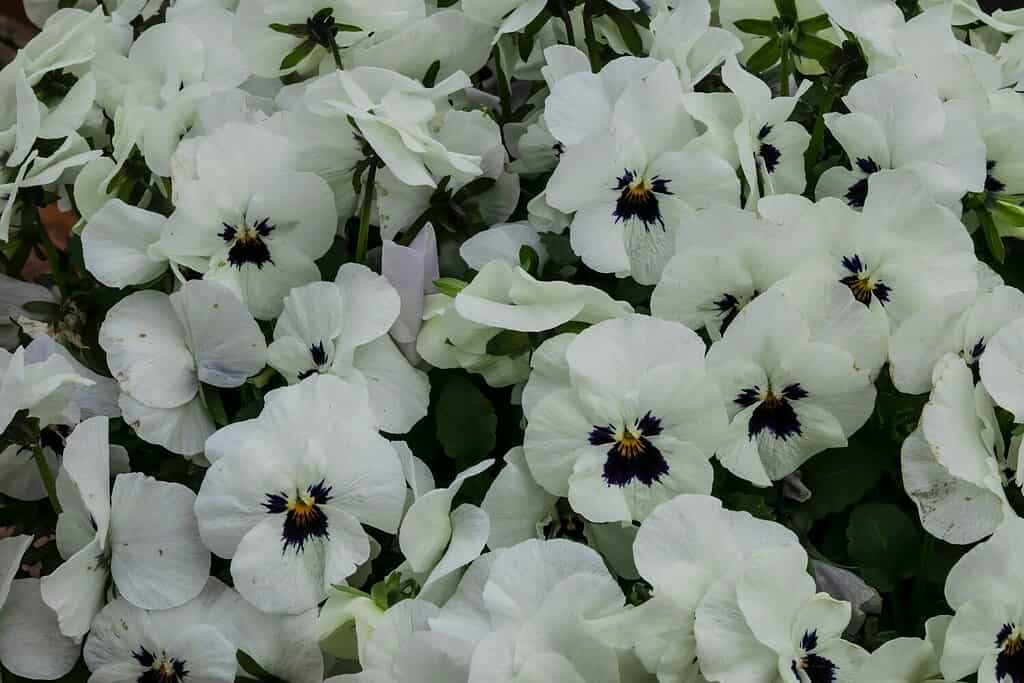
This type of pansy symbolizes purity and innocence.
©Brita Seifert/Shutterstock.com
White pansies have truly pristine petals and understated beauty. They are a timeless favorite in the world of flowers. These delicate blooms are renowned for their pure white color, which adds a touch of elegance and grace to gardens and floral arrangements.
White pansies get their pure white color from the absence of pigments. Unlike other pansy varieties that boast vibrant hues, white pansies lack the pigments responsible for coloration, resulting in their pristine and snow-white appearance. This simplicity in color, however, gives them a unique charm that complements various garden styles and floral displays.
While white pansies may not exhibit the dazzling colors of their counterparts, they carry a rich symbolism of their own. White is often associated with purity, innocence, and cleanliness. As such, white pansies symbolize purity of heart and intentions, making them a meaningful choice for weddings and other ceremonies that celebrate love and new beginnings. These blooms also convey a sense of simplicity and elegance, offering a timeless and classic aesthetic.
5. Orange
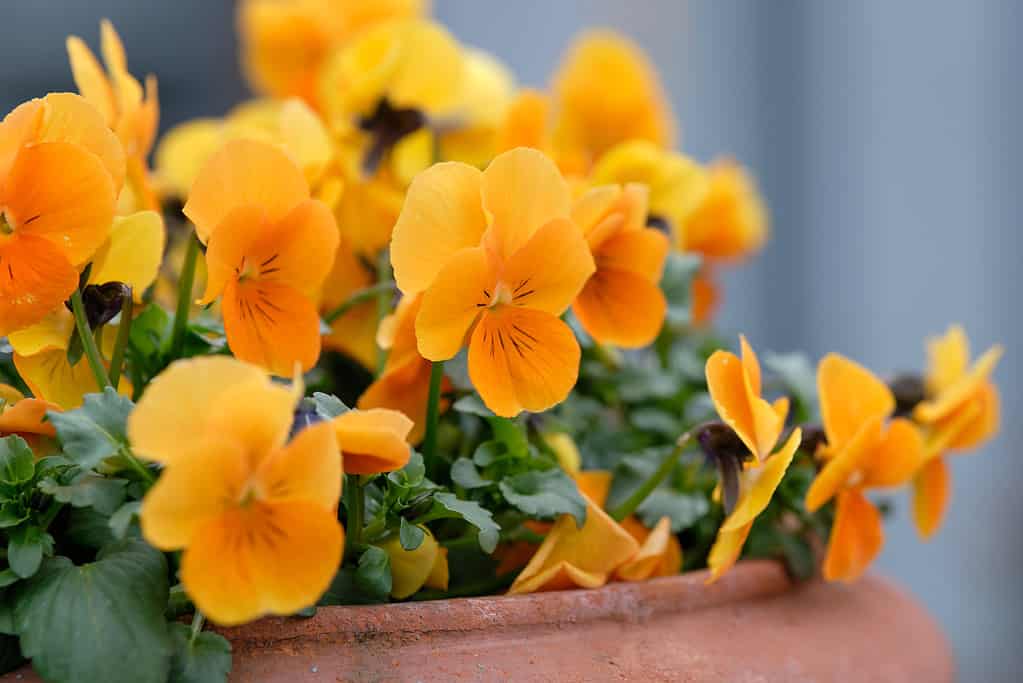
These pansies are rare and symbolize energy and creativity.
©franconiaphoto/iStock via Getty Images
Orange pansies, with their bold and vivid petals, are a captivating addition to any garden or floral arrangement. These vibrant flowers owe their striking orange hues to natural pigments known as carotenoids, which infuse their blossoms with a fiery and energetic charm.
Several noteworthy orange pansy varieties exist, each boasting its unique appeal. ‘Delta Premium Orange’ pansies, for instance, showcase bright and cheerful orange petals that radiate warmth and positivity. ‘Matrix Orange’ pansies offer a more intense shade of orange, resembling a brilliant sunset. ‘Sangria Orange’ pansies, on the other hand, feature a rich and deep orange-red hue, adding a touch of elegance to garden landscapes. These diverse options provide gardeners with an array of choices to incorporate vibrant orange into their outdoor spaces.
When it comes to their meaning, orange pansies convey sentiments of enthusiasm, energy, and creativity. Their fiery coloration represents the vibrant and lively aspects of life, making them a suitable choice for celebratory occasions and events. Orange is often associated with the sun and its life-giving energy, making orange pansies a symbol of vitality and optimism. These blooms inspire positivity and a sense of joy, making them an excellent choice to brighten up any garden or floral arrangement.
6. Blue
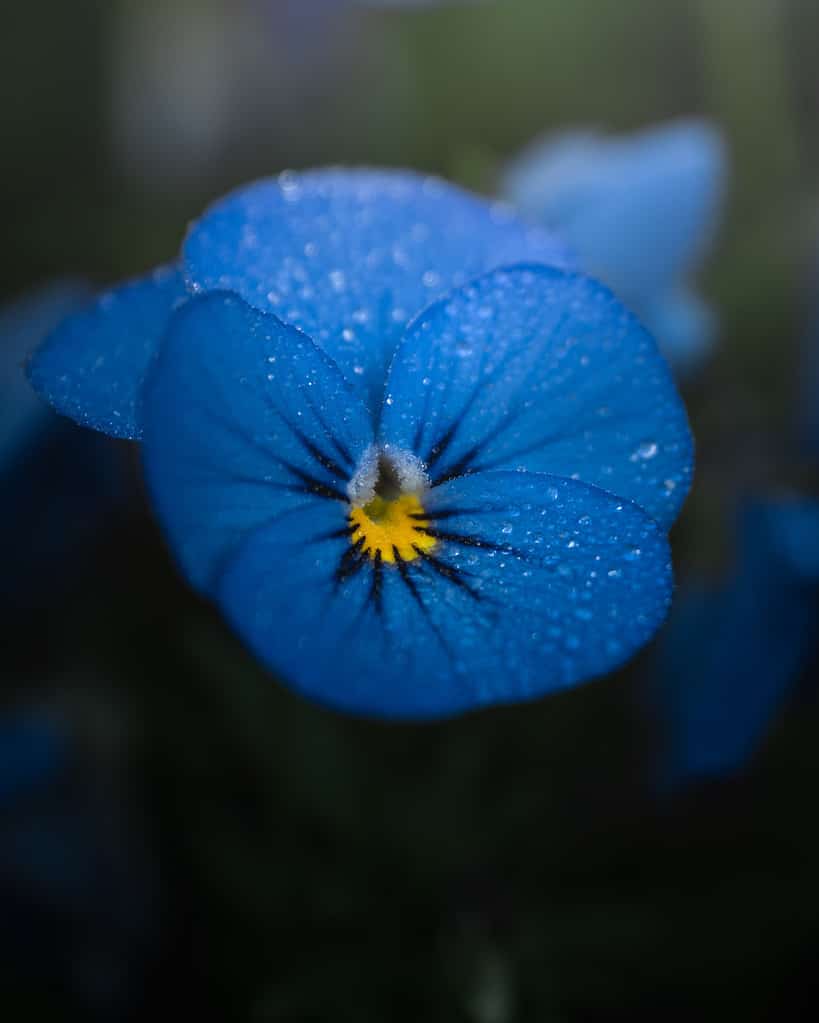
These pansies symbolize serenity and calm.
©Valentyna Bahmet/iStock via Getty Images
Blue pansies have a very calming and serene appearance. They are a delightful addition to gardens and floral arrangements. These captivating blooms achieve their serene blue shades through natural pigments called anthocyanins, which create a soothing and enchanting palette of blue hues.
A variety of blue pansies exists to cater to different tastes and garden designs. ‘Delta Blue’ pansies are renowned for their soft, pastel blue petals that exude tranquility. ‘Clear Crystals Blue’ pansies offer a deeper and richer shade of blue, reminiscent of a clear summer sky. ‘Ultima Morpho’ pansies provide a unique twist with their bi-colored petals, featuring a combination of blue and white that evokes images of a serene oasis. These diverse options allow gardeners to incorporate various shades of blue into their outdoor spaces, creating an atmosphere of peace and relaxation.
Symbolically, blue pansies convey a sense of calm, serenity, and depth. Blue is often associated with tranquility and introspection, making blue pansies a symbol of peace and mindfulness. These blooms inspire a sense of relaxation and inner peace, making them an excellent choice for gardens designed as sanctuaries or spaces for meditation. Blue pansies can also represent loyalty and trust, as the color blue has long been associated with steadfastness and reliability.
7. Multi-Colored

These pansies symbolize many different things, but they can be seen as a sign of diversity and complexity.
©Nitr/Shutterstock.com
Multi-colored pansies, with their vibrant and kaleidoscopic blooms, are a true testament to the creativity of nature. These captivating flowers showcase a stunning array of colors and patterns. They offer a visual feast that enthralls gardeners and floral enthusiasts alike.
What makes multi-colored pansies so captivating is their ability to display a myriad of hues within a single bloom. These pansies achieve their kaleidoscope of colors through a combination of various pigments and genetic traits. Each petal may sport a different color, resulting in a mesmerizing mosaic of shades that can include purples, yellows, blues, reds, and even whites. This natural phenomenon transforms them into living works of art.
Purple pansies, with their regal and captivating shades, are often included in the colorful palette of multi-colored pansies. Varieties like ‘Delta Premium Purple’ contribute deep purples and maroons to this colorful mix, adding depth and contrast to the overall composition. The presence of purple within multi-colored pansies serves to symbolize mystery, depth, and transformation. This compliments the other colors and patterns in these mesmerizing blooms.
Symbolically, multi-colored pansies are a celebration of diversity and complexity. Their intricate patterns and vibrant mix of colors inspire creativity, individuality, and appreciation of the unique beauty that each pansy brings to the bouquet or garden. These flowers symbolize the idea that beauty can be found in the blending of differences and the harmonious coexistence of various elements. They encourage us to embrace the diversity and complexity of life. They also encourage us to find beauty in the mosaic of experiences and perspectives that surround us.
Summary of Different Colors Of Pansies to Liven Up Your Garden
| # | Color |
|---|---|
| 1 | Purple |
| 2 | Yellow |
| 3 | Black |
| 4 | White |
| 5 | Orange |
| 6 | Blue |
| 7 | Multi-Colored |
The photo featured at the top of this post is © Ken Kojima /Shutterstock.com
Thank you for reading! Have some feedback for us? Contact the AZ Animals editorial team.







